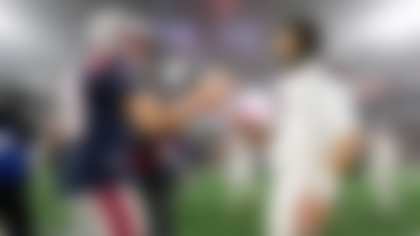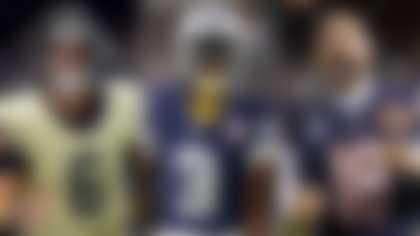FRAMINGHAM, Mass. -- For the first few weeks of the season, the engineers at Bose headquarters cringed each time Chuck Pagano slammed his headset to the turf or Bill Belichick grabbed the microphone in his fist and yanked it away so only a few targeted ears could hear his thoughts.
The engineers had spent more than a year walking sidelines and watching game tape -- not to analyze the players, but to scout Pagano, Belichick and their NFL coaching brethren and their sometimes maniacal mannerisms. They had seen the fury, felt the cold and rain, watched as coaches fiddled with wires. But those early weeks of the fall represented the start of a small technological revolution that came to the NFL sideline this season. Tablets were carrying digital images to replace photos that, in their earliest game-day use, were dropped from the press box in a sock. And in a first for the NFL, coaches and some other personnel -- including officials involved in replays -- were wearing headsets designed not only to relay play calls and conversations, but to deaden the deafening din of crowd noise and cranked up bass that makes speaking clearly, let alone thinking, seem impossible.
"We spent a lot of time learning," said Sean Garrett, the vice president of Bose's noise reduction technology group, "then ultimately designing to accommodate for that. Some of those behaviors are being very abusive to their tools."
The engineers had previously made similar equipment for pilots, military members and high-maintenance business travelers. For 20 years Bose executives had fielded questions from friends and employees about why they didn't make headsets for the NFL. But when the NFL asked Bose if it could help improve in-game communication, the high profile and high stress rigors of coaching presented peculiar challenges for those who had to essentially design and produce an entirely new piece of equipment in just seven months, before the start of the 2014 preseason.
"It reminds me of the five years we spent going to upstate New York to do blast testing for headsets for tank vehicles," said Bob Maresca, Bose's president and chief executive officer, who used to head the noise reduction group. "We learned they would hang the headsets on the gun turret and then blast. It would collapse our speakers. So we had to design speakers that could withstand that."
Billick: Truth about Philly's offense

Evaluation of Chip Kelly's offense tends to be as extreme as the scheme itself. Brian Billick provides a fair assessment. **READ**
Blast tests were not necessary for the NFL. Practically everything else was. The headsets were dropped repeatedly from 3 and 6 feet onto concrete after being stored at long periods at minus 55 degrees Celsius. Then they were taken to grass and turf fields where testers repeatedly spiked the headsets. They were tested in wind tunnels to see how much the noise would be picked up by the microphones on the mouthpieces. They were tried in rooms with intense reverberation and also in rooms with none at all. They were tested in some stadiums, including Penn State's. They were placed in a temperature chamber. (Cold is more of a concern than heat because plastic becomes brittle at very low temperatures -- special resins used in the space industry were deployed to ward off that risk.) The clamping mechanism that holds the headset in place had to be designed for a consistent fit, so that the headset would fit the same over a baseball cap like Tom Coughlin wears in warm weather to the ski cap and hoodie that Belichick wears under his headset in Foxborough's winter. The ear cups were angled at 15 degrees, because that most closely mimics the angle of the ear.
The technology behind the headset is essentially the same kind used in noise-canceling headphones donned by frequent fliers, but with a much larger range for the NFL. It was first developed at Bose in the late 1970s and has been used for pilot and military headsets. In 2000, Bose started selling noise-cancelling headphones to the public. Inside of the ear cup is a tiny speaker. A very small microphone measures the sound and then tells the speaker to move back and forth exactly opposite of the pressure wave created by the sound, dampening the signal and quieting much of the roar to little more than a low murmur. That, in turn, makes spoken words much clearer and understandable. Bose cites figures gleaned from the military that enhanced ability to communicate can increase mission effectiveness by 40 percent, according to Garrett.
One big complication for Bose in making the headsets: most coaches prefer to wear a headset that covers only one ear (the left ear is more popular), because they do not want to feel completely cut off from crowd noise and sideline conversation, especially with the referee. That's a relative oddity in Bose's business where two-ear headsets are the norm.
Tom Moore, the longtime NFL assistant coach, had never thought much about the cacophony around him on game day. He was so immersed in his play sheets -- first as a college assistant, then on Chuck Noll's staff in Pittsburgh -- that the din faded for him to an unobtrusive buzz.
That was until Moore worked for Dennis Green with the Minnesota Vikings, and Green told him what he was missing.
"Noise is an irritant," Moore said Green first told him. "It's very irritating and therefore you practice when we're playing on the road, we have the piped-in sound thing. You do become somewhat acclimated to it through the course of the season. But that's obviously why people try to get their fans involved in making noise and that's why you see offenses using silent counts and hand signals.
"This is certainly an advancement, there's no question. It's just another tool to make the game better."
Coaches already have a few ideas to make the headsets better, too, and some say it is communication between the play-caller and quarterback, who does not have the noise-cancelling feature in his helmet, is even more critical and in need of improvement than communication among coaches. This year, Bose shipped about 50 headsets to each stadium, for use by coaches on the sideline and in the booth, medical and officiating personnel. Teams travel with their own headsets in a special case and many coaches, creatures of habit and superstition, have taken to labeling their headset, particularly if their teams win when they wear a specific one.
Bose will likely make some changes to the headsets over the course of their four-year contract with the NFL. For next year, the changes will probably be modest and barely noticeable. The NFL mandates that every coach have exactly the same headset, and that any modification be made available to all teams so that no competitive advantage can be gained. Some teams have already asked if it would be possible to have two microphones on a dual-ear headset, so that coaches could listen to and communicate with the offense and defense simultaneously, a feature they do not currently have.
For now, though, even as the stakes of the games have grown higher and the weather worsens late in the season, no headsets have been casualties. Playoff races, of course, are also when crowds are the most raucous. With all the controlled tests long over, the engineers are most interested in the late-season results from labs that would be nearly impossible to duplicate: Kansas City and Seattle, the loudest stadiums in the NFL.
Follow Judy Battista on Twitter @judybattista.













